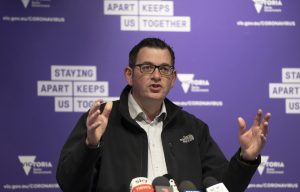Earlier this year, as the coronavirus took hold in countries around the world, the Australian state of Victoria did everything right. It was mid-March when Victoria first declared a state of emergency, which effectively gave health officials broad powers that included the ability to detain people, search premises without a warrant, and force people or areas into lockdown if it was considered necessary to protect public health.
Meanwhile, Australian Prime Minister Scott Morrison was at the time being accused of negligence for continuing to attend football matches despite his own recommendations for large events to be cancelled. The national chief medical officer told reporters that a lockdown, called for by many commentators, would “not achieve anything.” Less than a week later, the entire country went into lockdown for two months as cases doubled in just two days.
Victoria led the way by announcing a ban on all nonessential services ahead of the rest of the country and was then stricter in the enforcement of social distancing rules. Premier Daniel Andrews said the step was necessary or “our hospitals will be overwhelmed, and more Victorians will die.”
The lockdown proved effective in every state and territory. Tasmania, South Australia, West Australia, the Australian Capital Territory (ACT), Queensland, and the Northern Territory all had days and weeks at a time of no new reported cases. Victoria and New South Wales, with the largest populations, recorded single-digit new cases for days at a time between early May and June.
In mid-June, when the threat of being overwhelmed appeared to have passed, and the rest of the country began opening up, Victoria doubled down. There had been several new breakouts across Melbourne, mostly at meat processing centers and among large families. On the day that the state was due to ease restrictions, Andrews announced that the lockdown would be extended for a further four weeks. Two weeks in, the state’s new cases had tripled in just a 24-hour period. The lockdown would be tightened and extended for a further six weeks.
Health experts have found no clear explanation behind Victoria’s spike in cases and that is perhaps what is most troubling. Complacency has, of course, played a part. While many Victorians blame systemic failures in hotel quarantine, which includes allegations of illegal socializing between staff and claims of inappropriate contact between security and returned travelers, the public has also become less vigilant, experts say.
Nonetheless, while the rest of the country is now able to go to restaurants, bars, weddings, and funerals as well as go camping or engage in sports or other social activities, Victorians are allowed to leave the house only to exercise, go grocery shopping, for essential work or for medical purposes, and masks must be worn in public.
Despite all of Victoria’s efforts, the virus has hit it harder the second time around and much harder than any other Australian state or territory has experienced since the pandemic began. Victoria alone has now recorded more cases than the rest of the country combined.
While some states and territories continue to record no new cases, Victoria has recently topped nearly 500 new cases in just a 24-hour period. The dramatic increase in cases prompted Victoria’s neighbors to enact a hard border closure. Reports have since emerged of Victorians trying to get across the state border to see dying relatives but being denied entry.
As cases mounted, Victoria put nine public housing towers into hard lockdown. Around 3,000 residents weren’t allowed to leave for any reason. Victoria also commenced a testing blitz. Ambulances were parked on the end of residential streets in several of the most populated neighborhoods, while health care workers conducted door to door testing. With around 1.5 million tests completed and a population of just 5 million, Victoria now has one of the highest testing rates in the world.
Every day for weeks now Australians have watched Andrews’ live press conferences, anxiously awaiting the day he announces that new cases are showing a decline. Instead, they just keep rising, defying the lockdown and contact tracing efforts. Andrews has recently said that even tougher restrictions could be introduced.
What’s happening in Victoria has reignited calls for Australia to pursue elimination instead of suppression. But following a national cabinet meeting, Morrison announced that the government is recommitted to suppression as their lead strategy.
In Victoria’s plight there is perhaps a warning for the rest of Australia and other countries around the world emerging from lockdowns. It is a reminder that what has happened in Victoria could occur anytime, anywhere. No matter how hard you work, complacency will always be the enemy. What has happened in Victoria has been described by some health officials as “bad luck,” and nothing short of eliminating the virus can fend off bad luck.

































